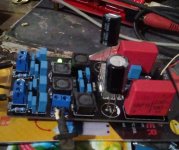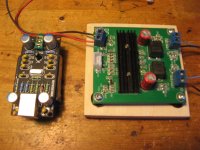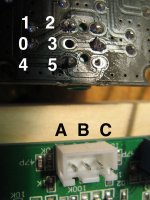Thanks for the feedback. I guess the advice to listen for yourself is the best advice anyway. For whatever it may be worth two rather different speakers I'm considering for these are the Fusion Alchemy 8's and a front ported bookshelf speaker with the Alpair 10.3. They will be used in an office space and 90% at modest to medium levels, with the occasional crank it up session at the end of the day. Also virtually no options on room placement since the will have to sit on a table top no more than a foot from the back wall which is a double pane laminated glass wall. The office is shared by 4 people and we all like music and one of us is a classically trained pianist, and we all love music but there is simply zero floor space for speakers. In any case I have hopes for the little TPA3116 in the office.
If no floor space, consider flat wall mount speakers like the Cornu or my flat foam core MLTL. Index in first post:
http://www.diyaudio.com/forums/full-range/223313-foam-core-board-speaker-enclosures.html
Maybe I've never understood ohm ratings on speakers, but, how did you derive that the Fusion 8 is 20 ohms and the MA 10.3 is 30 ohms?
Also thanks for the suggestion xrk but in this case the only available wall is all glass so a wall mount speaker isn't a possibility. However I would like to try one of those someday. Might be perfect for a room at home.
Also thanks for the suggestion xrk but in this case the only available wall is all glass so a wall mount speaker isn't a possibility. However I would like to try one of those someday. Might be perfect for a room at home.
What is the standard gain on the YJ boards? I need 26dB gain, what should I change the 'gain setting resistor' too?:
http://raw-sewage.net/images/diyaudio/tpa3116_yj_blue-black_label_v2.0.jpg
26dB gain results in 30k input impedance, to get the input HPF to 55Hz the input caps should be changed to ~96nF right?
http://raw-sewage.net/images/diyaudio/tpa3116_yj_blue-black_label_v2.0.jpg
26dB gain results in 30k input impedance, to get the input HPF to 55Hz the input caps should be changed to ~96nF right?
Maybe I've never understood ohm ratings on speakers, but, how did you derive that the Fusion 8 is 20 ohms and the MA 10.3 is 30 ohms?
Also thanks for the suggestion xrk but in this case the only available wall is all glass so a wall mount speaker isn't a possibility. However I would like to try one of those someday. Might be perfect for a room at home.
Use a glue-on exciter transducer to the glass wall. They turn the glass into a distributed mode loudspeaker. Really works. Buy a few cheap ones to try - you might be surprised how much bass you can get.
but, how did you derive that the Fusion 8 is 20 ohms and the MA 10.3 is 30 ohms
You see these max values from an impedance sweep of the driver, it varies with the cabinet and some can really flatten that peak, or add more peaks.
There must be a difference, if not in sound, but in heat that 10uH inductors and chip are emitting when driving 8 ohm speakers.If inductor is 10uH then 4ohm speakers. If 22uH then 8ohms. Assuming caps are 680nF.
But I use 4ohm on 22uH and 8ohm on 10uH and don't notice a difference.
I've replaced 10uH with 22uH (Coilcrafts), and DC power caps with Elko 1000µF/35V BC on YJ board a year ago, or soon as I've noticed this issue!
I have replace dc caps on yj blue black with Rubycon ZL 680uf/35v and input caps with wima mkp 10uf, Sound improve so much and I want to replace dc cap on sure TPA 3116.
Is easy to remove original DC caps on sure 3116 like removing DC caps on YJ blue board ?
Is easy to remove original DC caps on sure 3116 like removing DC caps on YJ blue board ?
Attachments
I have replace dc caps on yj blue black with Rubycon ZL 680uf/35v and input caps with wima mkp 10uf, Sound improve so much and I want to replace dc cap on sure TPA 3116.
Is easy to remove original DC caps on sure 3116 like removing DC caps on YJ blue board ?
The Sures are a little harder to work on replacing the caps. It took a lot of patience and a conical cone solder tip to remove the solder in the small holes. My solder sucker did not work well, nor did the desolder copper braids.
Conical tip from bottom side and once the hole melts use solder sucker from top. That is the only way I have found to clear holes to reinstall swapped out caps.
Conical tip from bottom side and once the hole melts use solder sucker from top. That is the only way I have found to clear holes to reinstall swapped out caps.
Ok thanks.
Laptop Brick
I want to build a YJ blue TPA3116 for a relative to use with a laptop. Don't know speakers yet. Do you think the typical 19V brick delivers enough current to power (charge battery) the laptop at the same time it's powering the TPA3116? Nearfield - low/moderate listening levels.
I want to build a YJ blue TPA3116 for a relative to use with a laptop. Don't know speakers yet. Do you think the typical 19V brick delivers enough current to power (charge battery) the laptop at the same time it's powering the TPA3116? Nearfield - low/moderate listening levels.
Probably yes. Low moderate music will draw fairly low current. If music ever goes to loud, power to charge laptop may go down and laptop kicks into UPS mode using battery on board. Try it - can't hurt.
FYI, regarding through hole cap swaps: I've never had any luck with a solder sucker. I've had some success with solder wicking braid.
But I've had 100% success using a "pin vise" and tiny drill bits to clean out the holes after pulling the cap. Heat one lead of the cap, and tilt the cap as much as possible. Repeat with the other lead. Might have to go back and forth multiple times, but it's pretty easy. Then use the hand-powered drill to clean out any left over solder.
On those cheap boards, I find I generally want to get rid of as much stock solder anyway, as mine is much easier to work with.
But I've had 100% success using a "pin vise" and tiny drill bits to clean out the holes after pulling the cap. Heat one lead of the cap, and tilt the cap as much as possible. Repeat with the other lead. Might have to go back and forth multiple times, but it's pretty easy. Then use the hand-powered drill to clean out any left over solder.
On those cheap boards, I find I generally want to get rid of as much stock solder anyway, as mine is much easier to work with.
I want to build a YJ blue TPA3116 for a relative to use with a laptop. Don't know speakers yet. Do you think the typical 19V brick delivers enough current to power (charge battery) the laptop at the same time it's powering the TPA3116? Nearfield - low/moderate listening levels.
I think so. Low/moderate levels at nearfield describes my setup exactly. I've used a free SPL meter app on my phone, and I'm usually around 70 dB or less. When I "crank it" I'm only reaching 80 dB or so.
I think my speakers are around 85 dB/watt/meter. My listening distance is right around a meter. So quick back of the envelope math says I generally need less than one watt per speaker. Of course there's transient peaks and such, but overall I think I could almost get away with a hamster running on a wheel to power my setup. 🙂
How is this board? It's saying 2X100W and from looks it's also having two TPA3116 chips.
Any suggestion, should i go for it.?
TPA3116 D2 Dual Channel 2 100W Digital Audio Amplifier Module for Arduino | eBay
I and several other guys on another forum have bought these (but from another vendor) and been very satisfied with them.
I just put a couple of tpa3116 amps in my car and they made an incredible upgrade in the sound! Super hard bass and treble🙂 But I'm suffering from some ground loop noise even though I got power from the the cd player power cables. I use a non isolated booster to get 23V to them, isolated is hard to find. I'm going to connect player chassi to signal cable earth and use rca transformers to get rid of the noise.
With relay and booster it cost just a little less than this card, TPA3116D2 Car Amplifier Board with The Acc Control 50 w 50 w Booster Module | eBay. Even with the noise setback I'm really impressed with tpa3116 in the car so I wondered if someone have tried the linked amp? I am considering recommending it to some of my friends for their boats.. I just wan't to know if its any good🙂
With relay and booster it cost just a little less than this card, TPA3116D2 Car Amplifier Board with The Acc Control 50 w 50 w Booster Module | eBay. Even with the noise setback I'm really impressed with tpa3116 in the car so I wondered if someone have tried the linked amp? I am considering recommending it to some of my friends for their boats.. I just wan't to know if its any good🙂
I just put a couple of tpa3116 amps in my car and they made an incredible upgrade in the sound! Super hard bass and treble🙂 But I'm suffering from some ground loop noise even though I got power from the the cd player power cables. I use a non isolated booster to get 23V to them, isolated is hard to find. I'm going to connect player chassi to signal cable earth and use rca transformers to get rid of the noise.
With relay and booster it cost just a little less than this card, TPA3116D2 Car Amplifier Board with The Acc Control 50 w 50 w Booster Module | eBay. Even with the noise setback I'm really impressed with tpa3116 in the car so I wondered if someone have tried the linked amp? I am considering recommending it to some of my friends for their boats.. I just wan't to know if its any good🙂
That looks nice. Resembles a SMAKN amp with boost converter. I have ever seen one with built in booster. Go for it.
B (earth) goes to 4or5. If you mix up the other two you only mix up right/left side so no biggy... But 0->L and 3->R. I have actully tried that dac and it sounds decent!
- Home
- Amplifiers
- Class D
- TPA3116D2 Amp


